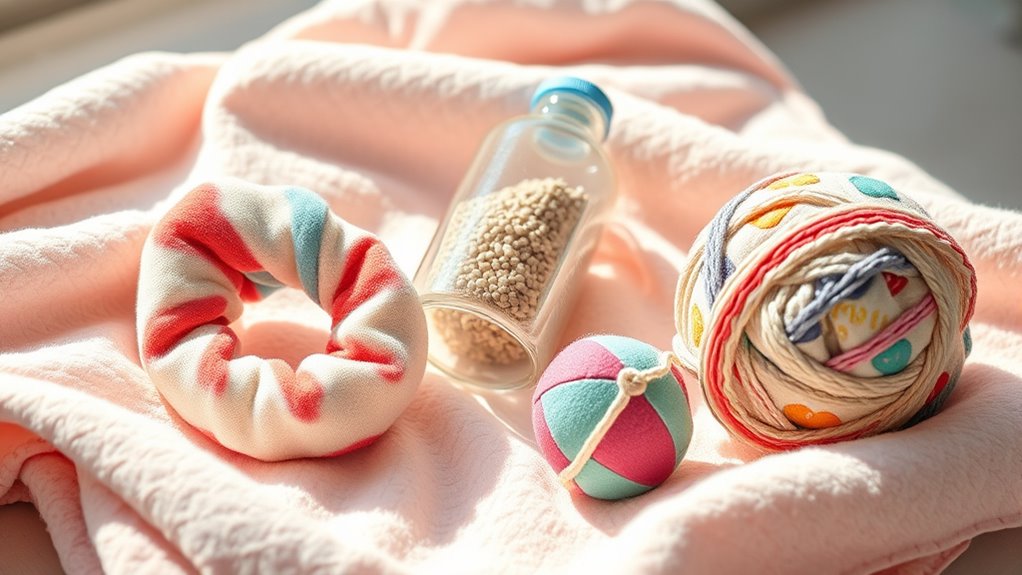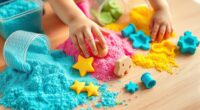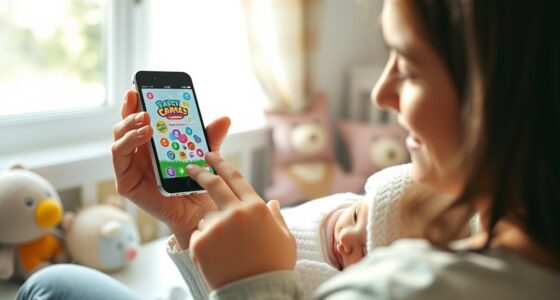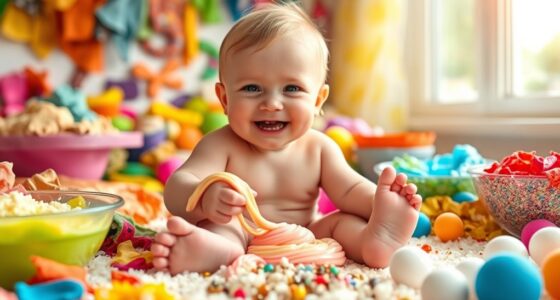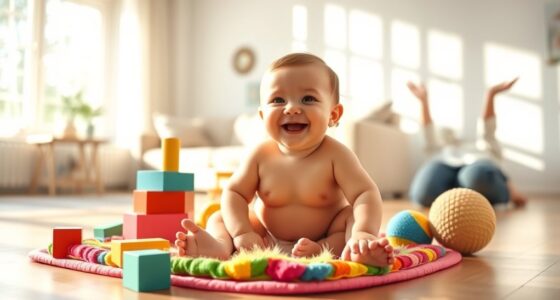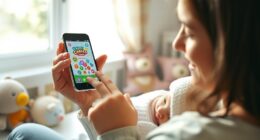You can make safe, fun baby toys at home by repurposing common household items. For example, fill empty plastic bottles with dried pasta or rice to create rattles, securely tape the openings, and supervise play. Sew fabric scraps into crinkly pouches or attach soft fabrics for sensory toys. Using silicone kitchen utensils or wooden spoons as teething toys adds variety. Keep safety in mind, check for hazards, and you’ll discover simple ways to craft engaging toys for your little one.
Key Takeaways
- Use safe, non-toxic household items like fabric scraps, plastic bottles, and wooden utensils, ensuring all materials meet safety standards.
- Create sensory toys by filling bottles with dried pasta or rice, sealing securely to prevent choking hazards.
- Sew or glue fabric scraps into crinkly pouches, plush toys, or teething rings, ensuring seams are secure and smooth.
- Repurpose household items such as plastic cups, bowls, or silicone kitchen utensils for stacking, sorting, or teething activities.
- Regularly inspect homemade toys for damage, replace worn parts, and supervise play to ensure safety and developmental appropriateness.
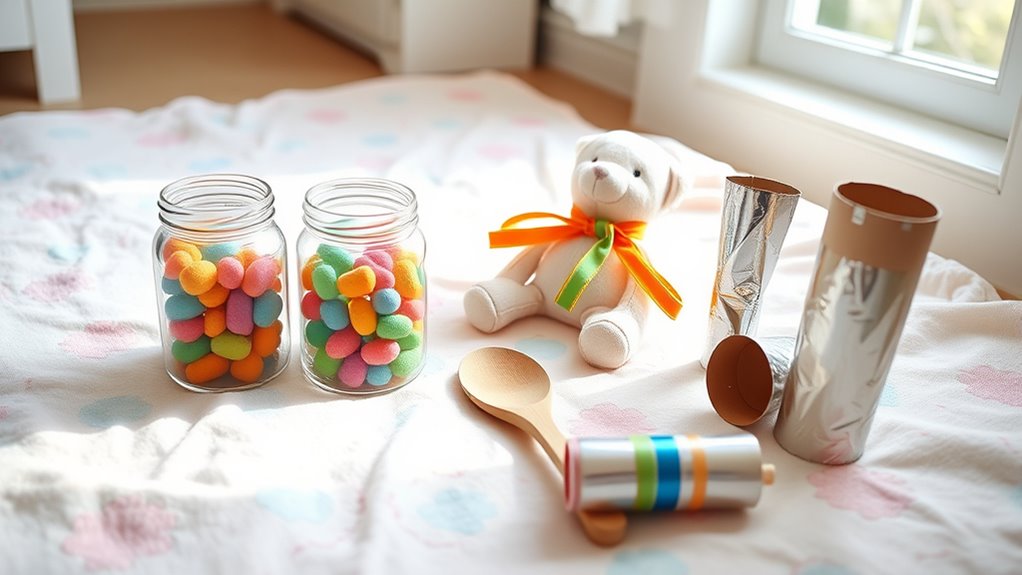
Are you looking for fun, safe, and affordable ways to keep your baby entertained? Creating DIY baby toys from household items is a fantastic way to do just that. But before you start, it’s essential to contemplate safety precautions. Always choose non-toxic, BPA-free, and food-grade materials when making toys for your little one. Avoid items with small parts that could pose a choking hazard, and ensure all toys are smooth, free of sharp edges, and well-made. When selecting materials, think about material alternatives that are safe and gentle for your baby’s delicate skin. Soft fabrics like cotton or fleece work well for plush toys, while sturdy, washable plastics or silicone can be used for teething rings or rattles. Recycled or upcycled items, such as clean cardboard tubes or fabric scraps, are excellent eco-friendly options, provided they meet safety standards.
Turning household items into baby toys is simple and rewarding. For example, a clean, empty plastic bottle filled with dried pasta or rice creates a satisfying rattle. Just make sure the cap is secured tightly or remove it altogether to prevent choking. Cover the opening with a piece of tape or a piece of cloth if needed, and double-check for sharp edges. Soft, colorful fabric scraps can be sewn into small, crinkly pouches or plush toys with squeakers inside—just ensure all seams are secure so stuffing or squeakers don’t come loose. For teething toys, silicone kitchen utensils or clean, unpainted wooden spoons can work well, especially if you sand down rough edges and confirm they’re free of harmful finishes.
Interactive toys can also be made from household items. For example, stacking plastic cups or bowls in different sizes encourages coordination and motor skills. These are lightweight, easy to clean, and provide visual stimulation. You can also repurpose old socks into sensory toys by filling them with crinkly materials like foil or fabric scraps, then tying the open end securely. Just remember, always supervise your baby during playtime to prevent any accidents. Keep in mind that safety is paramount, so regularly inspect homemade toys for wear and tear, replacing or repairing as needed. By choosing safe materials and paying attention to safety precautions, you can create a variety of fun, engaging toys that are both budget-friendly and tailored to your baby’s developmental needs. This not only saves money but also allows for personalized, unique gifts that your little one will love and cherish.
Frequently Asked Questions
Are Homemade Toys Safe for All Age Groups?
You should always consider if your homemade toys are safe for all age groups. Use age-appropriate materials, avoiding small parts that could pose a choking hazard for babies and toddlers. For older children, ensure toys are sturdy and free from sharp edges. Always supervise playtime and regularly check toys for wear and tear. This way, you keep play safe and fun for everyone, regardless of age.
How Can I Sterilize DIY Toys Effectively?
To sterilize DIY baby toys, you should use safe sterilization methods like boiling, steaming, or wiping with a disinfectant safe for children. Always follow safety precautions by checking the material’s compatibility and avoiding harsh chemicals. Boiling toys for 5-10 minutes effectively kills germs, while steam sterilization offers another safe option. Regular sterilization guarantees your baby’s toys stay clean and safe for play, reducing the risk of infections.
What Non-Toxic Materials Are Best for Baby Toys?
Your baby’s safety is paramount, and choosing non-toxic materials is like shielding them with an impenetrable fortress. Opt for eco-friendly materials such as organic cotton, food-grade silicone, or untreated wood, which meet strict safety standards. These materials are gentle, durable, and free from harmful chemicals, ensuring your little one explores and learns safely. Prioritize these safe options to create toys that nurture curiosity while protecting their health.
How Do I Ensure Homemade Toys Are Developmentally Appropriate?
You want to make sure your homemade toys are developmentally appropriate by choosing age appropriate choices that align with your baby’s developmental milestones. Consider their current abilities—like grasping or crawling—and select simple, safe materials that encourage exploration and learning. Always supervise play, avoid small parts for younger babies, and regularly check for any signs of wear or hazards. This way, your DIY toys support their growth safely and effectively.
Can DIY Toys Replace Store-Bought Options Entirely?
This question is as big as a mountain! While DIY toys can be cost-effective and eco-friendly, they can’t fully replace store-bought options. Store-bought toys often meet safety standards and offer diverse stimulation. DIY toys excel in customization and environmental impact, but for all-encompassing development and safety, mixing both is best. You provide your little one with a balanced, engaging play environment that benefits their growth and your wallet.
Conclusion
Who knew that turning everyday household items into baby toys could be so simple and fun? It’s almost ironic—sometimes the best playthings are right under your nose, waiting to be repurposed. So next time you’re about to toss something out, think twice. With a little creativity, you’ll have a safe, engaging toy ready in no time. Who needs store-bought when your own home can be the ultimate toy factory?

